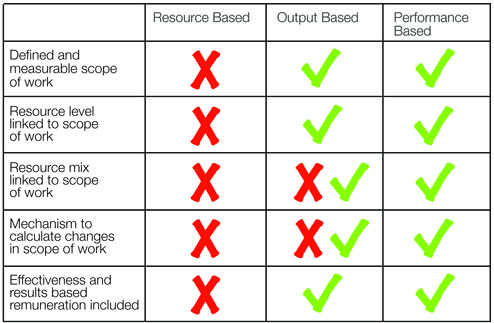Many marketers have moved from media commissions and service fees to retainer-based remuneration models. Yet although retainers often provide a minimum of management during the course of the agreement, they can become problematic at renewal or review time, especially if there are reductions in the marketing budget, requiring reductions in the retainer.
Recently these have been highlighted to our clients in a number of ways:
1. Retainer reduction negotiation:
A client had a Retainer based on the delivery of a number of full-time equivalent staff (FTEs) of 6.8 to deliver all of the account management, strategy and creative concept work required. There was no defined scope of work other than a loose description of the services to be provided under the contract.
With the reduction in the overall marketing budget of 25%, the client wanted to reduce the agency retainer by the same amount. However, the agency responded that the actual FTE level had been running at 9.18 (supported by timesheets) or 35% higher than contracted and that a 25% reduction in spend and associated work would require a 10% increase in the current retainer and an increase in FTEs to 7.5 to be equitable.
2. Reduction in scope of work:
Faced with 20% in marketing budget year on year the client had reduced the number of projects under the contracted scope of work from 243 to 195 to reflect the 20%. These projects also contributed to a 22% reduction in production costs based on the previous year.
However, when presenting the new scope of work to the agency, they responded with a reduction in retainer fee of only 9% as they maintained that the mix and associated complexity of the work included in the new scope were labour intensive and not reflective of the resource reduction required.
Benchmarking is the key
In both cases, the situation lead to a stalemate between the client and agency until we were able to undertake a benchmarking exercise to calculate and set the resources required for a specific scope of work and then provide a methodology to calculate the resources required with the corresponding change in scope.
Ironically both of these could be avoided if the retainer had been established with best practice in the first place.
What is Best Practise?
There are three different types of retainers in relation to best practice
Resource-Based
The vast majority of retainers are Resource Based in that they lock in a level and mix of resources provided under the retainer with at best a vague and unmeasurable scope of work with terms like “Provide all account management and creative services” etc. The problem with this model is there is no transparency or accountability beyond the agency timesheet system. If you want to know if you are currently paying a resource-based retainer, ask to see the current scope of work reconciled against the actual scope delivered. If neither the agency nor the marketing team can provide this, then start to worry.
Output-Based
This is a big improvement on the Resources Retainer, and starts with a defined scope of work and then links the level and mix of agency resources to the scope. Often marketers are not in a position to predict the scope with any certainty, in which case the previous year’s scope can be used and then a mechanism to track the actual outputs against the proposed and then adjust the resources and remuneration is a better option.
In fact, the measure of the quality of an outputs based model is the level of measurement and control it provides to the client and the transparency it provides to all parties.
Performance-Based
The best model is one that takes the Outputs Based model and then includes a performance-based component to the remuneration based on effectiveness and results. This could be either a bonus on top of overhead and profit recovery for the agency, or it could be the way the agency profit is calculated.
Either way, it acts to align the agency to the same goals and objectives as the client, while remunerating them in a transparent and accountable way for the outputs the agency delivers.
Going from good to better to best
If you are currently using a Retainer Based remuneration model then there is no reason not to have the best model in place.
Increased transparency and accountability along with the ability to manage and adjust the retainer to your changing needs, without protracted disagreements and negotiations with your agencies, is a clear advantage for marketers.





